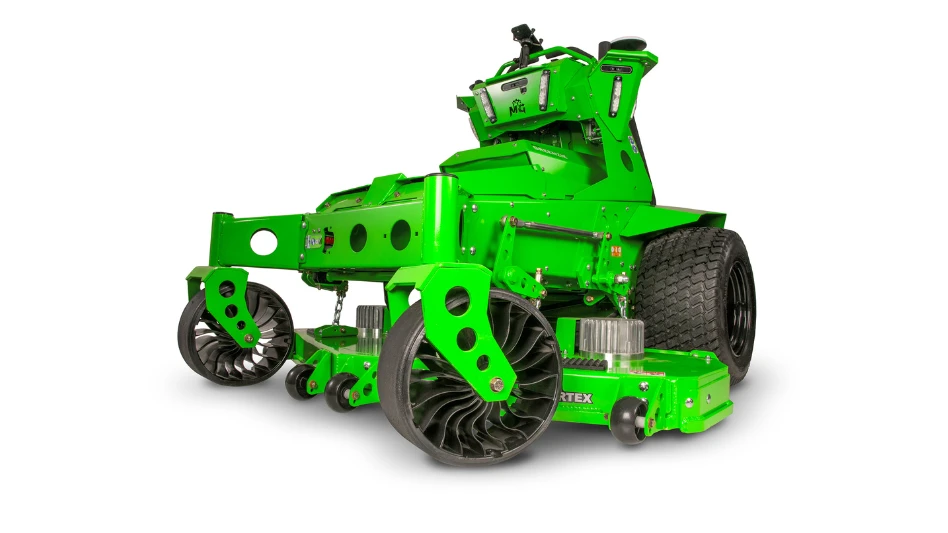Most lawn care customers don’t understand the importance of fall fertilization. As winter approaches, the last thing on their minds is lawn care. “Once the end of September comes, people forget about their lawns,” says Bob Ottley, president of One Step Tree & Lawncare, North Chili, N.Y. “That’s a shame because it is the perfect time to fertilize.”
It may seem like a waste to fertilize a lawn with snow on the way, but the fall is when plant roots soak up the nutrients they need to produce thick, green turf come springtime. Missing a fall fertilization means missing the best opportunity for a healthy lawn next year.
Ottley says One Step Tree & Lawncare has offered fall fertilization as part of its complete lawn care program for 29 years. The Integrated Pest Management program consists of five visits. At least three visits are fertilizer applications, and two are for treating pests and weeds as needed, depending on the season and specific property. “It’s a balanced fertilizing program with pest and weed controls where necessary,” he explains.
The company currently has 4,500 customers, 80 percent of which are residential. To find new customers, Ottley relies on his current ones. And while he says he doesn’t lavishly reward customers for referring the company, he makes sure to send a $20 check as a thank you. Apparently it’s working because more than half of One Step’s new business comes from referrals.
When it comes to offering fall fertilization specifically, Ottley notes two main challenges. For one, lawn care operators are at the mercy of the weather. So while he tries to apply fertilizer before the leaves fall, that is not always possible. “Customers think if you spread the fertilizer over the leaves, they will lose all of it when the leaves are raked,” he says. “So when the leaves do start to fall, scheduling can become a bit of a challenge.” To handle the scheduling difficulties, Ottley says his employees leave notes asking customers to call when their leaves are cleaned up. In some situations, “we will blow the leaves off and put the fertilizer down,” he says. But that’s only if the crews need to finish the work, and the leaf cleanup is minor.
The second challenge is dealing with customers’ aforementioned lack of understanding about the importance of fall fertilization. “They think the fall is too late to do anything,” he says. “Some customer education needs to take place.” Most of that education occurs when a client first calls to inquire about the lawn care program. If they seem hesitant about the fall fertilization or ask to skip it, Ottley explains its significance. “We tell our customers if they’re only going to do one thing, they should do it in the fall,” he says. “We tell them they miss the best application of the year by not having a fall fertilization.”
Ottley applies a slow-release nitrogen fertilizer in October and early November. “During this time, the grass is slowing down its top growth, but the color is still very green,” he says. The old rule said a high phosphorus fertilizer should be used to stimulate root growth in the fall, Ottley says, but those rules have changed. “The plant needs a lot of nitrogen in the fall to help thicken the grass,” he says. “This is especially true when we also apply a weed control in the fall, which can create thin spots.” High nitrogen fertilizers in the late fall take advantage of what is left of the warm soil temperature, and the plant uses the nitrogen to stimulate root growth. Because the soil in his location is high in phosphorus already, Ottley says the fertilizer they use has none.
No matter what season the fertilization occurs, Ottley’s pricing structure remains the same. He includes the cost of fall fertilization in his complete package price, which he calculates by averaging the cost for all visits. To figure out how much one fertilizer application costs, he looks at the property’s square footage. The larger the lawn, the less it is per square foot, but Ottley estimates he charges about $7 to $9 per 1,000 square feet. Ottley notes his material costs typically run around 20 percent and direct labor – labor costs directly related to the delivery of the service – is around 35 percent. All these factors must be considered when determining a fertilization price in order to ensure a profit at the end of the day. The biggest mistake LCOs make is not charging enough for their services, says Ottley. “You have to know and understand your expenses and come up with a good hourly rate. It’s hard to grow a business profitably if you’re too cheap.”
Get curated news on YOUR industry.
Enter your email to receive our newsletters.
Explore the September 2005 Issue
Check out more from this issue and find your next story to read.
Latest from Lawn & Landscape
- Connect, Control & Conserve with Horizon Technical Services
- Use Horizon's Parts Hotline
- How I built a Top 100 company
- Horizon’s Exclusive TurfGro Fertilizer
- Grow your business with mosquito control
- LandCare adds 2 branches in SoCal, promotes Aleman to branch manager
- Spray them away
- PERC helps debut propane direct-injection fuel system at ACT Expo 2025






